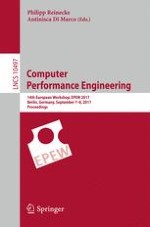This book constitutes the refereed proceedings of the 14th EuropeanWorkshop on Computer Performance Engineering, EPEW 2017, held in Berlin,Germany, in September 2017.
The 18 papers presented together with the abstracts of two invited talks in this volume were carefully reviewed and selected from 30 submissions. The papers presented at the workshop reflect the diversity of modern performanceengineering, with topics ranging from advances in Markov models; advances in quantitative analysis; model checking; and cyber-physical systems to performance, energy and security.
